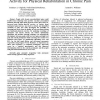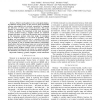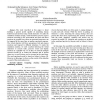ACII
2015
Springer
8 years 6 months ago
2015
Springer
Abstract—In emotion recognition from speech, several wellestablished corpora are used to date for the development of classification engines. The data is annotated differently, a...
ACII
2015
Springer
8 years 6 months ago
2015
Springer
—The recognition of continuous dimensional emotion remains a challenging task due to large variations in the expression of emotion, and the difficulty of modeling emotion as tem...
ACII
2015
Springer
8 years 6 months ago
2015
Springer
—People with chronic musculoskeletal pain would benefit from technology that provides run-time personalized feedback and help adjust their physical exercise plan. However, increa...
ACII
2015
Springer
8 years 6 months ago
2015
Springer
Abstract—Mimicry and laughter are two social signals displaying affiliation among people. To date, however, their relationship remains uninvestigated and relatively unexploited ...
ACII
2015
Springer
8 years 6 months ago
2015
Springer
Abstract—Human expressions are often ambiguous and unclear, resulting in disagreement or confusion among different human evaluators. In this paper, we investigate how audiovisual...
ACII
2015
Springer
8 years 6 months ago
2015
Springer
ACII
2015
Springer
8 years 6 months ago
2015
Springer
Abstract—In this paper, we study perception of intensity incongruence between auditory and visual modalities of synthesized expressions of laughter. In particular, we investigate...
ACII
2015
Springer
8 years 6 months ago
2015
Springer
—We propose a novel and general framework, named the multithreading cascade of rotation-invariant histograms of oriented gradients (McRiHOG) for facial expression recognition (FE...
ACII
2015
Springer
8 years 6 months ago
2015
Springer
Abstract—We introduce iHEARu-PLAY, a web-based multiplayer game for crowdsourced database collection and – most important – labelling. Existing databases (with speech and vid...
ACII
2015
Springer
8 years 6 months ago
2015
Springer
—The work described in this paper is about building a general model capable of simulating human behaviour and emotions using virtual characters. To make the simulation realistic ...



